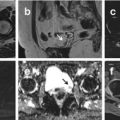and Jurgen J. Fütterer2, 3
(1)
Department of Radiological Sciences, Oncology and Pathology, Sapienza University of Rome, Rome, Italy
(2)
Department of Radiology and Nuclear Medicine, Radboudumc, Nijmegen, The Netherlands
(3)
MIRA Institute for Biomedical Technology and Technical Medicine, University of Twente, Enschede, The Netherlands
Testicular Cancer
It can be divided into primary tumors and secondary tumors (lymphoma, leukemia, and metastasis). Primary tumors can be also classified into testicular germ-cell tumors and testicular nongerm-cell tumors. MR imaging is an important imaging tool in the evaluation of scrotal masses, in addition to ultrasound.
Most intratesticular solid masses represent malignant tumors, whereas 97 % of the extratesticular masses are benign.
Germ-Cell Tumors (95 % of Testicular Carcinomas)
They are categorized as seminoma or nonseminomatous tumor. Nonseminomatous germ-cell tumors include embryonal carcinoma, yolk sac tumor, teratoma, and choriocarcinoma.
US is the best diagnostic tool to identify and characterize scrotal mass. Seminomas tend to be homogeneous in echotexture, whereas nonseminomatous germ-cell tumors are more heterogeneous. CT is the study of choice for the evaluation of retroperitoneal adenopathies and lung metastasis.
Seminomas are isointense to normal tissue on T1- and hypointense and homogeneous on T2-weighted MR images compared to normal testis; they enhance less than normal testicular tissue. Nonseminomatous tumors are more heterogeneous than seminomas in all MRI sequences, as they contain areas of high and low signal intensity both with T1- and T2-weighted images.
Nongerm-Cell Tumors
Nongerm-cell tumors include Leydig cell tumor, Sertoli cell tumor, and granulosa cell tumor. Most of these tumors are benign; combinations of several of these tumors can also occur.
The most common nongerm-cell tumor is Leydig cell tumor. It is usually well-marginated, encapsulated, solid and homogenous mass, sometimes difficult to differentiate from germ-cell tumors, in particular from seminoma. It is isointense on T1-weighted images and hypointense on T2-weighted images; in some cases, it can contain foci of increased signal intensity both on T1- and T2-weighted images.
Testicular Torsion
The acute scrotum often presents as pain, swelling, or a combination of sudden onset. It can occur at all ages of childhood, but with two peaks: one in the newborns and the other during puberty. It consists of a twisting of testis and spermatic cord within scrotum; it causes acute scrotal pain because of vascular occlusion and infarction. Torsion of the testicular appendage should be suspected in younger boys. The role of ultrasound in the acute scrotum is to narrow the differential diagnosis to allow conservative management or expedite surgery. US is the imaging modality of choice. With acute torsion, MRI may demonstrate a twisting spermatic cord, called whirlpool sign, with a hypointense signal. Testis appears heterogeneous on all image sequences. Enhancement is low if blood flow is compromised, whereas enhancement could be very intense if detorsion has occurred.
Stay updated, free articles. Join our Telegram channel

Full access? Get Clinical Tree




